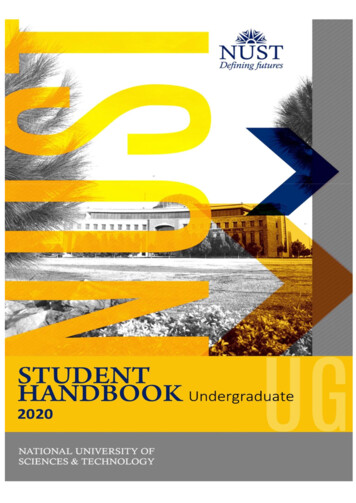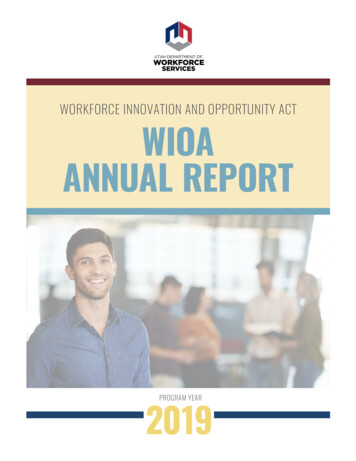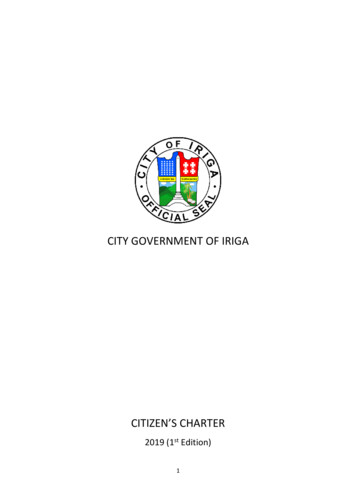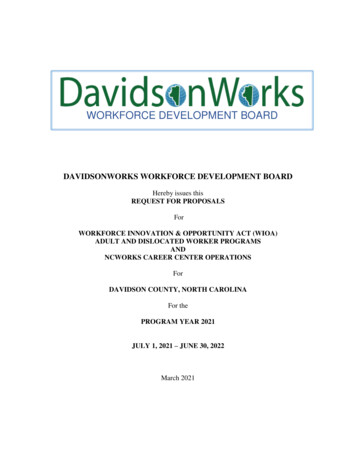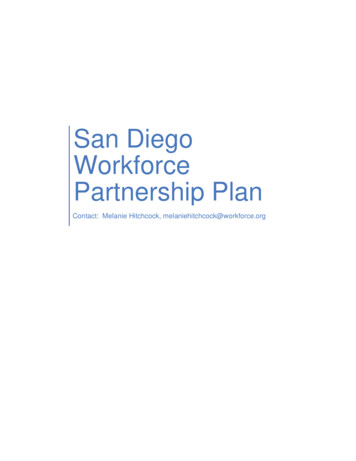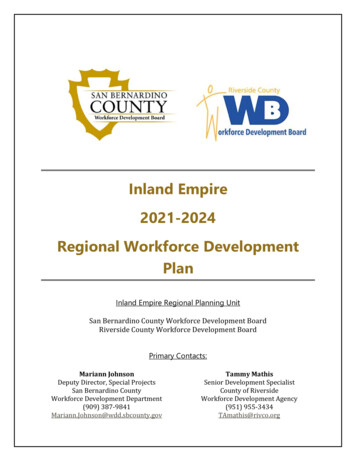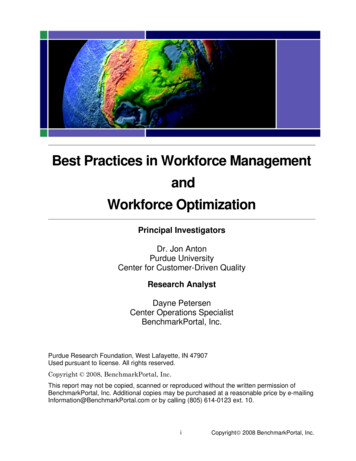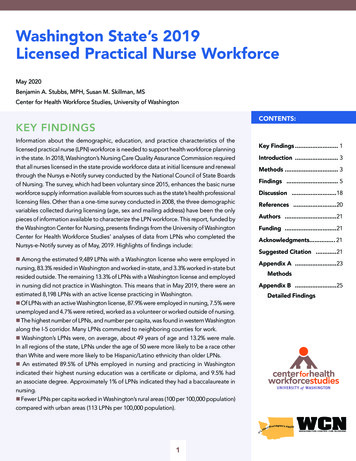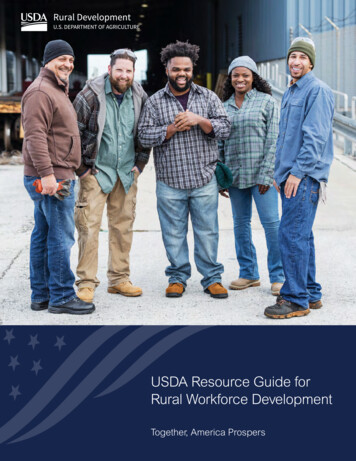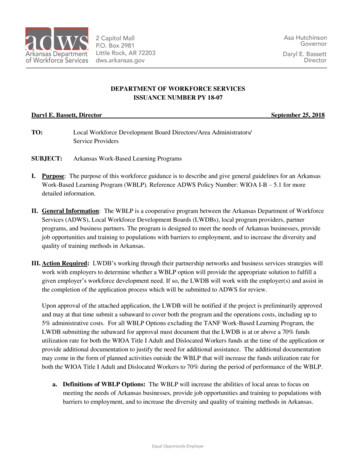
Transcription
DEPARTMENT OF WORKFORCE SERVICESISSUANCE NUMBER PY 18-07Daryl E. Bassett, DirectorTO:Local Workforce Development Board Directors/Area Administrators/Service ProvidersSUBJECT:Arkansas Work-Based Learning ProgramsSeptember 25, 2018I. Purpose: The purpose of this workforce guidance is to describe and give general guidelines for an ArkansasWork-Based Learning Program (WBLP). Reference ADWS Policy Number: WIOA I-B – 5.1 for moredetailed information.II. General Information: The WBLP is a cooperative program between the Arkansas Department of WorkforceServices (ADWS), Local Workforce Development Boards (LWDBs), local program providers, partnerprograms, and business partners. The program is designed to meet the needs of Arkansas businesses, providejob opportunities and training to populations with barriers to employment, and to increase the diversity andquality of training methods in Arkansas.III. Action Required: LWDB’s working through their partnership networks and business services strategies willwork with employers to determine whether a WBLP option will provide the appropriate solution to fulfill agiven employer’s workforce development need. If so, the LWDB will work with the employer(s) and assist inthe completion of the application process which will be submitted to ADWS for review.Upon approval of the attached application, the LWDB will be notified if the project is preliminarily approvedand may at that time submit a subaward to cover both the program and the operations costs, including up to5% administrative costs. For all WBLP Options excluding the TANF Work-Based Learning Program, theLWDB submitting the subaward for approval must document that the LWDB is at or above a 70% fundsutilization rate for both the WIOA Title I Adult and Dislocated Workers funds at the time of the application orprovide additional documentation to justify the need for additional assistance. The additional documentationmay come in the form of planned activities outside the WBLP that will increase the funds utilization rate forboth the WIOA Title I Adult and Dislocated Workers to 70% during the period of performance of the WBLP.a. Definitions of WBLP Options: The WBLP will increase the abilities of local areas to focus onmeeting the needs of Arkansas businesses, provide job opportunities and training to populations withbarriers to employment, and to increase the diversity and quality of training methods in Arkansas.
Option A: On-the-Job Training (OJT) – OJT is occupational training that is providedthrough a contract with a participating employer and provided to an eligible participant whileengaged in paid productive work in a job that meets WIOA criteria. Under the WBLP, OJTparticipant wages will be reimbursed to the employer based on inputs that considers the sizeof the business, if the occupation is in-demand, if the training leads to an industry recognizedcredential, if the training is also part of a Registered Apprenticeship program, and if thetrainee is an individual with a barrier to employment. Participant wage reimbursements of upto 75% are allowable to compensate for the participant’s training. Local areas will be requiredto determine eligibility of participants. For participants to be determined eligible for OJT, theindividual must meet not only Adult, Dislocated Worker, or Out-of-School Youth eligibilityrequirements for an OJT (reference ADWS Policy Number: WIOA I-B – 3.4) but alsoeligibility requirements for an OJT as described in ADWS Policy Number: WIOA I-B – 3.4.Participants must be unemployed at the times of being determined eligible for WIOA Title IB services.1. Option A: On-the-Job Training (OJT)-TANF Work-Based Learning ProgramOptionIf the following conditions apply, the business may be eligible for an increasedreimbursement amount:a. The prospective employee is an Arkansas resident;b. The prospective employee is a parent with a child under the age of 18 livingin the home, receiving or participating in the TEA program;c. The new employee is entitled to the same benefits as similarly situatedemployees within the company;d. The employer agrees to report any changes to the assignment of theemployee;e. The employer agrees to pay the employee a minimum of 10/ Hour; andf. The employer agrees to hire the employee full-time (35hrs /week)Qualifying businesses are eligible for the following:a. Receive 100% reimbursement from ADWS for the first six months of theemployee’s wagesParticipants must be referred to WIOA Title I (Adult, Youth, and Dislocated Workers) anddocumentation of eligibility maintained in all participant files, even if it is determined that theindividual cannot be enrolled in WIOA Title I services. Case management for individualsreferred into the TANF WBL will be coordinated among an assigned TEA Case Manager andWIOA Title I service providers if they are determined eligible.This option will be funded by TANF and are limited to TEA clients, therefore, TEA CaseManagers will provide full case management and coordinate with the WIOA Title I casemanager for documentation, Individual Employment Plan development, and providingadditional services not covered by TANF. The TEA Case Manager will determine eligibilityfor other TANF services specifically approved for this program and not funded under theaward and other services allowed to TEA clients, including:a. An employer retention bonus when the employee works six months past thesix-month subsidy period and receive an additional subsidy of 1,500.00.Documentation must be provided to the assigned TEA Case Manager toreceive this subsidy.2
b. Reimbursement for required clothing or tools purchased on the employee’sbehalfc. Other TANF ServicesNOTE- These services should not be included in the cost proposal section.(Please complete the TANF WBLP section in the Application Form)As stated above, the TANF WBLP option does not require that the LWDB be at or above a70% funds utilization rate for WIOA Title I Adult and Dislocated Workers funds. Option B: Paid Internships – Paid internship is a type of work experience and therefore is aplanned, structured learning experience that takes place in a workplace for a limited period oftime and leads to a career. Under the WBLP, internships may be provided when registeredapprenticeships are not available or are not appropriate for the employer. Interns in thisprogram must be unemployed individuals who are determined eligible for the Adult,Dislocated Worker, or Out of School Youth program. Interns must be attending occupationalclasses in the fields of their internships. The occupational training must lead to a recognizedcredential. Local program providers are responsible for determining the eligibility ofparticipants for the program, their eligibility for training services, the eligibility of thetraining program, and the appropriateness of the training program and the workplace for theparticipant. Each intern will be paid up to 20 hours per week for up to one year while workingin a position that provides training in a field for which the intern is attending occupationaltraining. The coordination of funding and the rate of pay to the intern will be determinedbefore the contract is issued to the employer. ADWS Policies WIOA I-B – 3.3 (OccupationalSkills Training) and 3.4 (Work Experience) must be followed. Option C: Work Experience – Paid work experience is a planned, structured learningexperience that takes place in a workplace for a limited period of time, and is often neededfor individuals with barriers to employment in order to enter or re-enter the workplace. Underthe WBLP, Work Experience is for organizations who agree to train individuals with barriersto employment and to help them find unsubsidized jobs. Local areas will help identifybusinesses, determine eligibility, and needed services for participants, and provide casemanagement and follow-up services. Wages to be paid will be proposed by the employer inthe application, but they may be negotiated by the employer, ADWS, and the programprovider as appropriate. All regulations and guidance in ADWS Policy No. WIOA I-B – 3.8must be followed. Option D: Incumbent Worker Training – Incumbent worker training is training designedto meet the needs of an employer or group of employers to retain a skilled workforce or avertlayoffs. This WBLP training option is not permitted to provide occupational training for newhire needs. Unlike other WBLP options, incumbent workers are not individually determinedeligible for the program, although they must meet basic eligibility requirements: at least 18years old, a U.S. citizen or otherwise authorized to work in the United States, and incompliance with selective service requirements. The employers, and not the workers, arechosen for the incumbent worker program. The approved employer chooses the individuals to3
be trained consistent with guidance provided in ADWS Policy No. WIOA I-B – 3.6.Approved employers will be reimbursed for a percentage of the cost of training, with thepercentage dependent on the size of the business, the demand of the occupation for which theworkers are to be trained, whether the training leads to a credential, and if the workers havebarriers to employment. All regulations and guidance in ADWS Policy No. WIOA I-B – 3.6must be followed.Multiple WBLP options may be included in one application, but should not be duplicated in the costproposal section. For example, if the employer is willing to accept TEA clients or WIOA clients for an OJTcohort, both sections in “Option A” should be completed. The flexibility of the employer should beexplained in the project description. In the cost proposal, only one position should be included, not aWIOA and TEA version of the same position.If there is no way to avoid duplication, for example, if the employer were willing to provide a part-timeinternship or a full-time OJT, then separate applications should be submitted.TANF/WIOA Work Experience for Resource Rooms ADWS is also introducing the TEA/WIOA Work Experience Program. This program willallow Local Boards to apply for up to 6 month Work Experience for TEA clients. Thisprogram is intended to improve the outcomes of the participants and provide neededresources to workforce system. Local Boards may be eligible to receive an award to fund a Work Experience for co-enrolledWIOA and TANF clients.1. To be eligible for the program the Local Board must document that they are abovethe 70% fund utilization rate for WIOA Title I Adult and Dislocated Workers fundsat the time of application or can otherwise document that additional resources areneed to staff the resource rooms.2. The client must be co-enrolled in both TANF and WIOA Title I services. The attached Work-Based Learning Application will not be required for this program. Aletter addressed as follows:Re: TANF/WIOA Work Experience for Resource RoomsWIOA Assistant Director’s OfficeP.O. Box 2981Little Rock, AR 72203The letter should clearly request an interest in the program and provide attachments tosupport the financial need as described in paragraph “1.” and “2.” above.II. Related Resources: Arkansas Work-Based Learning Program - ADWS Policy Number: WIOA I-B – 5.1 On-the-Job Training – ADWS Policy Number : WIOA I-B – 3.4 Paid Internships - ADWS Policy Number : WIOA I-B – 3.3 and 3.44
Work Experience - ADWS Policy Number: WIOA I-B – 3.8 Incumbent Worker Training - ADWS Policy Number: WIOA I-B – 3.6 Application – Arkansas Business-Driven Training ProgramIII. Inquiries: Any questions and concerns are welcome and may be submitted to the following email:wioa@arkansas.govIV. Expiration Date: Ongoing5
Daryl E. Bassett, Director September 25, 2018 . utilization rate for both the WIOA Title I Adult and Dislocated Workers funds at the time of the application or . individual must meet not only Adult, Dislocated Worker, or Out-of-School Youth eligibility requirements for an OJT (reference ADWS Policy Number: WIOA I-B - 3.4) but also .
